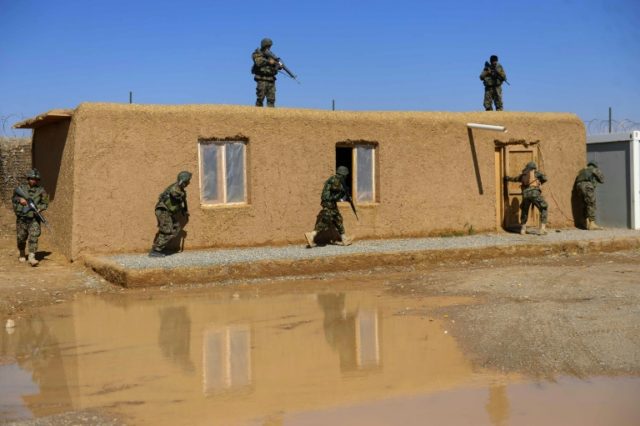Deadly clashes between jihadi rivals the Taliban and the Islamic State (ISIS/ISIL) have intensified this week in eastern Afghanistan’s Nangarhar and Kunar provinces, reportedly leaving several terrorists dead and displacing hundreds of families.
Neighboring Nangahar and Kunar provinces border Pakistan, which the United States, India, and Afghanistan have repeatedly accused of harboring the Afghan Taliban and other jihadis.
In an interview with Khaama Press (KP) published on Thursday, Ataullah Khogyani, a spokesman for the governor of Nangarhar, confirmed that “clashes intensified between Taliban and ISIS militants in [the province’s] Khogyani and Shirzad district in the past two days, leaving several militants dead.”
Khogyani also verified the accuracy of KP’s report on Wednesday that ISIS killed five Taliban narco-jihadis and “arrested” four others in Nangarhar.
The Nangarhar spokesman revealed that the fighting has displaced at least 300 families, noting that there are efforts underway to provide them with aid. Officials in Kunar told KP similar battles between ISIS and the Taliban had taken place in the province’s Chapa Dara district.
Kunar Gov. Abdul Satar Mirzakwal reportedly indicated that “3000 families have been displaced due to the clashes which still continue between the two sides in Chapa Dara district.”
The Pentagon has identified Nangarhar, one of the top opium-producing provinces in Afghanistan, as home to the primary stronghold of ISIS’s Afghanistan wing known as the Islamic State-Khorasan (ISIS-K), noting that the group also operates in neighboring Kunar province.
Jihadis like the Taliban generate most of their funding from trafficking and cultivating opium, the primary ingredient in heroin, some of which is fueling the unprecedented number of drug overdoses in the United States. Afghanistan remains the world’s top producer of opium despite billions of American taxpayer funds devoted to counternarcotics in the war-ravaged country.
In December 2018, the Pentagon reported that U.S.-backed Afghan National Defense and Security Forces (ANDSF) had “weakened” ISIS-K.
However, the U.S. Special Inspector General for Afghanistan Reconstruction (SIGAR), a watchdog agency, noted in its March report on high risks to America’s multi-billion dollar nation-building efforts that “the group poses a greater security threat to the Afghan people and security forces than it did in 2016,” adding:
Since the 2017 HighRisk List, IS-K has gone from being concentrated in a few districts in Nangarhar Province in eastern Afghanistan to having a limited presence in two other provinces—Kunar and Jowzjan.
The Trump administration’s decision in 2017 to continue the U.S. counterterrorism mission to pursue terrorist organizations in Afghanistan—distinct from its participation in the [NATO] RS [Resolute Support] train, advise, and assist mission—gives the ANDSF an obvious advantage in confronting IS-K and has had important consequences for Afghan security.
SIGAR credited the Taliban with slowing ISIS expansion into northern Afghanistan, adding:
Yet, IS-K remains able to carry out mass-casualty attacks on major population centers. The number and lethality of IS-K attacks in Afghanistan increased since the last High-Risk List. According to the UN, in 2017, there were 100 attacks claimed by or attributed to IS-K that caused 399 civilian deaths, and in 2018, there were 138 attacks resulting in 681 civilian deaths (a 71% increase in civilian deaths)
SIGAR acknowledged that “it is unlikely” the Afghan security forces “could curtail or eliminate IS-K on its own without military, financial, and intelligence assistance from the United States and other donor nations.”
U.S. President Donald Trump’s intensified peace-seeking efforts with the Taliban, which do not involve ISIS, have recently hit a roadblock over the Taliban’s refusal to allow the Afghan government to participate in the talks.
The Trump administration has made the reconciliation between Kabul and the Taliban the primary goal of its strategy to end the war.
Negotiations have yielded some draft agreements, namely the withdrawal of foreign forces in exchange for assurance from the Taliban that it will not allow international jihadis like al-Qaeda and ISIS from operating on Afghan soil. Nevertheless, the Taliban has come out against proposals to leave behind a residual U.S. counterterrorism force to ensure it keeps its promises. The Taliban has intensified attacks amid the negotiations.
When compared to the same period last year, there was a nearly 25-percent drop in civilian casualties in Afghanistan to 1,773 (581 killed, 1,192 injured) amid peace negotiations during the first three months of this year, the United Nations reported.
The U.N. noted that pro-government forces, including the ANDSF and U.S.-NATO troops, killed more innocent people than jihadi groups like the Taliban and ISIS. Jihadis, however, did injure more civilians than pro-Kabul forces.
Since ISIS expanded into South Asia in 2015, establishing a branch in Afghanistan, the Taliban has been fighting the group for influence, power, and territory.
Taliban jihadis, who control or contest about half of Afghanistan’s territory, remain the most prominent terrorists in the country. Thousands of ISIS jihadis remain active outside the Middle East despite the fall of the group’s so-called caliphate in Iraq and Syria.

COMMENTS
Please let us know if you're having issues with commenting.